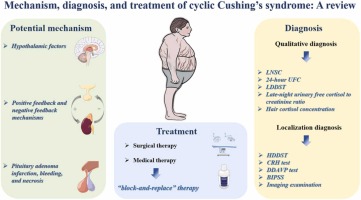
CUSHING’S SYNDROME
It is the condition caused by excessive production of cortisol for a long period of time, which occur more often in age between 20-40 years of age and have three time higher frequency in women than in men.
CAUSES OF CUSHING SYNDROME
- It is caused by the long term use of steroid drugs
- Also occur from over production of cortisol by the adrenal gland
TYPES OF CUSHING SYNDROME
-
PITUTARY CUSHING SYNDROME
- About 60-70% cases of Cushing syndrome are caused by excessive secretion of Adenocorticotropic hormone (ACTH) due to a lesion in the pituitary gland, most common a corticotroph adenoma
- It is characterized by bilateral adrenal cortical hyperplasia and elevated ACTH level
- This cases show therapeutic response on administration of high doses of dexamethasone which suppresses ACTH secretion and causes fall in plasma cortisol level
-
ADRENAL CUSHING SYNDROME
- Approximately 20-25% cases of Cushing syndrome are caused by disease in one or both adrenal gland
- These include adrenal cortical adenoma, carcinoma and less often cortical hyperplasia
- The group of cases is characterized by low serum ACTH levels and absence of therapeutic response to administration of high dose of glucocorticoid
-
ECTOPIC CUSHING SYNDROME
- About 10-15% of cases have an origin in ectopic ACTH elaboration by non-endocrine tumors
- Most often tumor is an oat cell carcinoma of the lung but other lung cancers and pancreatic tumor have also been implicated
- The plasma ACTH level is high in these cases and cortisol secretion is not suppressed by dexamethasone administration
-
LATROGENIC CUSHING SYNDROME
- Prolonged therapeutic administration of high dose of glucocorticoids or ACTH may result in Cushing syndrome e.g.; in organ transplant recipient and in autoimmune disease
- These cases are generally associated with bilateral adrenocortical insufficiency
CLINICAL FEATURES OF CUSHING SYNDROME
- Central or truncal obesity contrasted with relatively thin arms and leg, buffalo hump due to prominence of fat over the shoulder and rounded oedematous moon-face.
- Increases protein breakdown resulting in wasting and thinning of the skeletal muscles
- Atrophy of the skin and subcutaneous tissue with formation of purple striae on the abdominal wall
- Osteoporosis and easy breakable of the thin skin to minor trauma
- Systematic hypertension is present in 80% of cases because of associated retention of sodium and water
- Impaired glucose tolerance and diabetes mellitus are found in about 20% cases
- Amenorrhea hirsutism and infertility in many women
- Insomnia depression confusion psychosis
DIAGNOSIS OF CUSHING SYNDROME
- History taking
- Physical examination
- Ct scan
- Ultrasonography
- Corticotropin releasing factor CRF stimulation test
- Dexamethasone suppression test
- Blood test
- X-rays of the skull
MANAGEMENT OF CUSHING SYNDROME
1. MEDICAL MANAGEMENT
- Dopamine- agonist cabergoline
- Somatostatine- analog pasireotide
- Steroidogenesis inhibitors like ketoconazole, metyrapone
- Glucocorticoid receptor directed drug like mifepristone
2. SURGICAL MANAGEMENT
- Transsphenoidal adenomectomy can be done
3. RADIATION THERAPY
- If the disease is not controlled with surgery then conventional external beam or stereotactic radiosurgery are effective in controlling cortisol level and also tumor growth in many cases
4. NURSING MANAGEMENT
I. ASSESSMENT
- Enlarged abdomen should be assessed
- Striae over the abdomen and buttocks round face and facial hair should be assessed
- Vitals sign should be monitored
- Monitor neurological status
- Fluid volume level
II. NURSING DIAGNOSIS
- Fluid volume excess related to sodium retention causing edema and hypertension
- Impaired skin integrity related to altered and edema
- Self- care deficit related to muscle wasting and fatigue
- Anxiety related to surgery
- Self- esteem disturbance related to altered physical appearance
- Risk for injury related to surgical procedure
III. GENERAL NURSING MANAGEMENT
- Monitor vitals sign
- Administer medications per cardex
- Weight should be taken every morning
- Use 3% NaCl infusion carefully
- Monitor and analysis all the lab report
- Skin care and oral care should be done strictly
- Monitor neurological status to detect any changes
- Encourage for low sodium diet
- Orally intake of water should be done
- Monitor the surgery site and prevent infection
- Give teaching to patient and visitors for long term monitoring for sign and symptoms of tumor recurrence
COMPLICATIONS OF CUSHING SYNDROME
Untreated Cushing’s syndrome complication include
- Diabetes
- Enlargement of any tumors
- Fractures due to osteoporosis
- Hypertension
- Renal stone
- Any serious infection
